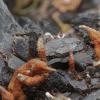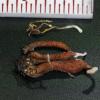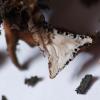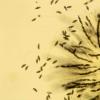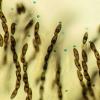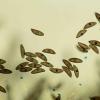
08-11-2025 00:29
 Francois Guay
Francois Guay
I found this species in Quebec, Canada, on herbace

04-11-2025 09:07
Hello.A suspected Hymenoscyphus sprouting on a thi

04-11-2025 12:43
 Edvin Johannesen
Edvin Johannesen
Hi! One more found on old Populus tremula log in O

03-11-2025 21:34
 Edvin Johannesen
Edvin Johannesen
These tiny (0.4-0.5 mm diam.), whitish, short-stip

https://www.inaturalist.org/observations/213846964
I have recently received some of this material (with more on the way), which I had the pleasure of scoping a few days ago, and have uploaded some micrographs to the following link:
https://drive.google.com/drive/folders/18qLCra0pSKYHKUwIvoXl11ANb_BostFF?usp=drive_link
These images will soon accompany the linked observation. The germ slit is spore-length, straight to slightly curved, and spores appear to be biguttulate when fresh, and 1-guttulate when dried. Spore measurements are as follows:
(11) 11.6 - 13.9 (15.9) × (3.6) 3.9 - 4.4 (4.9) µm
Q = (2.5) 2.7 - 3.2 (3.7) ; N = 50
Me = 12.7 × 4.3 µm ; Qe = 3
It is exceedingly rare for me to see a lignicolous Lindquistia anamorph co-occurring with any kind of teleomorph, whether in Latin America or elsewhere. I know of only a handful of examples worldwide where their connection has been observed, referring chiefly to the records of Poronia (=Podosordaria) ingii from the Canary Islands, first by Rogers & Læssøe in 1992, later by Ribes et al. in 2011. Like P. ingii, the sp. linked above is non-fimicolous. Unlike, P. ingii, this collection was found in a burn pile on charred bits of miscellaneous types of wood, in a human-disturbed/landscaped area in northern Louisiana. Its stromata are also quite a bit more pigmented, to say nothing of other macro- and micromorphological differences.

this resembles Podosordaria truncata (Pat. & Gaillard) P. Martin, likewise occurring on burnt soil and burnt wood, known from Venezuela and French Guiana and probably elsewhere in central and south America, which differs by more pulvinate stromata and larger ascospores. (Mycologia, 84(2), 1992, pp. 166-172).
Good luck!
Jacques



